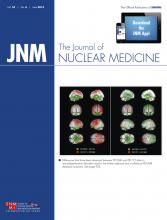Pediatric radiopharmaceutical guidelines: Treves and Lassmann provide commentary and background on the recent release of international harmonized recommendations on radiopharmaceutical administered activities in children.
Page 869
PET tau radiotracers: Shah and Catafau present an overview of current studies and developments in PET radiotracers as new-generation biomarkers targeting tau proteins in neurodegenerative disease.
Page 871
99Mo/99mTc supply diversification: Dick looks at efforts and projects underway to provide reliable and uninterrupted supplies of these essential radionuclides and previews an article in this issue of JNM on an alternative approach to 99mTc production.
Page 875
Adjuvant 131I-lipiodol in HCC: Dumortier and colleagues compare the effectiveness of a single dose of postoperative adjuvant intraarterial 131I-lipiodol with unlabeled lipiodol in reducing the rate of intrahepatic recurrence of hepatocellular carcinoma.
Page 877
Prognostic factors in H&N cancer: Pak and colleagues report on a systematic literature review of volumetric parameters and a metaanalysis of the prognostic value of metabolic tumor volume and total lesion glycolysis in patients with head and neck cancer.
Page 884
Tumor heterogeneity in rectal cancer: Bundschuh and colleagues investigate textural parameters from 18F-FDG PET/CT for their predictive and prognostic capabilities in patients with rectal cancer.
Page 891
MTV and TLG in pancreatic cancer: Lee and colleagues assess the prognostic value of metabolic tumor volume and total lesion glycolysis measured on 18F-FDG PET/CT in pancreatic cancer patients who underwent resection with curative intent.
Page 898
Imaging prostate cancer metastatic burden: Kwee and colleagues explore the prognostic significance of metabolically active tumor volume measurements from 18F-fluorocholine PET/CT in men with castration-resistant prostate cancer.
Page 905
PET/CT in NK/T-cell lymphoma therapy: Khong and colleagues determine the accuracy of midtreatment 18F-FDG PET response assessment in patients with newly diagnosed or relapsed histologically proven extranodal natural killer/T-cell lymphoma.
Page 911
SPECT, cardiac CT, and TID: Halligan and colleagues use cardiac CT to evaluate atherosclerotic lesions and the severity of coronary artery stenosis in patients with transient ischemic dilation of the left ventricle with or without SPECT myocardial perfusion defects.
Page 917
PET/MR and PET/CT in brain: Hitz and colleagues compare the qualitative performance and results of 18F-FDG imaging obtained with integrated PET/MR and conventional PET/CT in the same patients examined for assessment of cognitive impairment.
Page 923
11C-AZD2184 PET in AD: Ito and colleagues look at the binding and kinetic properties of this radioligand for amyloid senile plaques in individuals with Alzheimer disease and in control subjects.
Page 932
11C-PK11195 PET in SPMS: Rissanen and colleagues determine whether translocator protein imaging can be used to visualize diffuse inflammation in the periplaque area and in normal-appearing white matter in the brains of patients with secondary progressive multiple sclerosis.
Page 939
Neuroinflammation in CFS/ME: Nakatomi and colleagues use 11C-(R)-PK11195 PET to identify and characterize neuroinflammation in patients with chronic fatigue syndrome/myalgic encephalomyelitis.
Page 945
PET in OCD neurosurgery: Suetens and colleagues describe the utility of 18F-FDG PET in exploring mechanisms leading to clinical improvement in patients with obsessive–compulsive disorder who undergo capsulotomy or deep-brain stimulation interventions.
Page 951
11C-PHNO reproducibility in human brain: Gallezot and colleagues evaluate the reproducibility of binding parameters and test–retest variability with this agonist radioligand for PET imaging of dopamine receptors.
Page 960
Hepatobiliary scintigraphy: Ziessman provides an educational overview of current diagnostic uses of hepatobiliary scintigraphy, appropriate methodologies for performing cholescintigraphy for various clinical indications, related pharmacologic interventions, and image interpretation criteria.
Page 967
PET and GIP receptors: Gourni and colleagues describe the development and evaluation of a new class of radioligands with the potential to be used for in vivo targeting of glucose-dependent insulinotropic polypeptide receptor–positive tumors.
Page 976
PET and MR in lung cancer: Schelhaas and colleagues investigate the molecular and cellular determinants of 18F-FLT PET and diffusion-weighted MR imaging in lung carcinoma xenografts.
Page 983
Integrin αvβ6–targeted SPECT: Liu and colleagues detail the synthesis and in vitro and in vivo evaluation of a 99mTc-labeled peptide as a SPECT radiotracer for imaging of integrin αvβ6 expression.
Page 989
Dual-modality prostate imaging: Lütje and colleagues report on the potential of dual-modality prostate cancer imaging with the monoclonal antibody D2B, directed against an extracellular domain of prostate-specific membrane antigen, labeled with both 111In and a near-infrared fluorescent dye.
Page 995
Imaging EGFR downregulation: Ma and colleagues determine whether molecular imaging with near-infrared fluorescence and PET probes can sensitively detect trastuzumab-induced epidermal growth factor receptor downregulation in tumor-bearing mice.
Page 1002
99mTc-PNA imaging and EGFR mRNA: Zhao and colleagues describe a method for preparation of single-photon–emitting mRNA antisense peptide nucleic acid probes and evaluate their feasibility for imaging epidermal growth factor receptor mRNA overexpression in malignant tumors.
Page 1008
Cyclotron production of 99mTc: Bénard and colleagues report on the development of a comprehensive approach to production of 99mTc using a single medical cyclotron, with sufficient resulting quantities to supply a large urban area.
Page 1017
Ethanol-based 68Ga postprocessing: Eppard and colleagues describe the feasibility of a method for replacing acetone with ethanol in purification and concentration of generator-derived 68Ga.
Page 1023
Radiolabeled irreversible peptide: Marquez and colleagues evaluate a 64Cu-labeled affinity peptide tag that binds covalently and irreversibly to vascular endothelial growth factor as a PET imaging agent.
Page 1029
Optical imaging in RCC: Muselaers and colleagues study the potential of fluorescence imaging to detect clear-cell renal cell carcinoma tumors in nude mice using the chimeric monoclonal antibody girentuximab conjugated with a near-infrared dye.
Page 1035
- © 2014 by the Society of Nuclear Medicine and Molecular Imaging, Inc.







